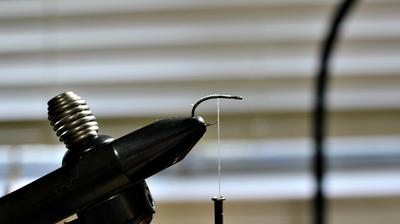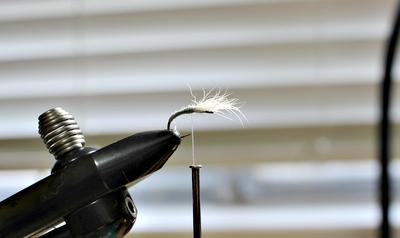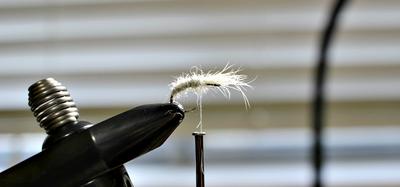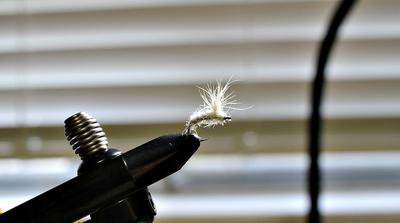Simple Snowshoe Hare Emerger
by John Evans
(San Antonio, TX)

Build thread base.
Simple, buggy flies and tenkara go together like ketchup and fries. Lately, I’ve been tying a super-simple emerger pattern that works well in my local creeks and streams and thought I’d share it with readers.
Snowshoe hare emergers are nothing new, nor are patterns that use just snowshoe hare and thread; but this fly combines both elements. It’s really just a simplified mash-up between Bob Wyatt’s Snowshoe Hare Emerger and Fran Betters’ “Usual” pattern. It’s also an excellent pattern to learn if you’re just starting to tie flies. The only tough part is dubbing the snowshoe hare underfur or fuzz, but even that step is fairly easy with a touch of wax.
All you need is a hook, some thread, and a snowshoe hare’s foot. Here’s the process:
For the hook, I use a size 14, Firehole 316 (“Firehole Sticks”), which is barbless. The thread is white or gray Danville 140 denier waxed Flymaster. The only other material is a little tuft of snowshoe hare fur from the bottom of a snowshoe rabbit’s foot.
First, wind a body of thread down toward the bend of the hook. Then, wind the thread back up to within a third of the hook length of the eye. (See first photo.) Snip a small clump of fur from the bottom on the hare’s foot and pull the underbody fuzz from the cut end. (Experience will teach you how much you need.) Save all the fuzzies for the body dubbing. Tie in the tuft of the snowshoe rabbit fur so that it extends forward, just past the eye of the hook. Snug the tuft down firmly with a few good wraps so that it stays in place and doesn’t twist around the hook. Clip the end of the fur that remains toward the bend of the hook and wrap thread over it until you make a nice, tapered body. (See second photo.)
Next, dub the underfur behind the tuft toward the bend of the hook, covering all the thread. I dub the body well down to the bend of the hook and then spiral the bare thread forward over the dubbing back to the tuft or shuck. This is the hardest part of the tying process because snowshoe hare fuzz has a mind of its own. A bit of dubbing wax on the thread helps to control it. It’s okay to leave the body a bit raggedy. (Third photo)
Finally, move the thread in front of the clump of fur you have tied in and dub a little more fuzz in front of the clump to form a nice, buggy head. This step also helps the clump to stand up. Whip finish at the head. (Fourth photo)
This makes a simple, effective fly for several species, including panfish, bass, and stocker trout. I dress the tuft of fur with a bit of floatant and fish the fly in the film of the water with good results. After catching a fish, I simply wash off the slime, apply a little more floatant to the shuck, and maybe give the fly a false cast or two. The whitish, creamy hare fur is easy to see, and the fish really go for it because the body hangs down into the water. They often will strike this emerger when they’re reluctant to rise to a high, dry fly. The snowshoe hare dubbing increases the visibility and buoyancy and gives a scruffy, buggy appearance. Most snowshoe hare emergers are dressed in smaller sizes, but the size 14 hook is easier for me to manage.
Give it a go and see what you think. Sometimes super-simple is all you need!
Return to Your Tenkara Stories.
“The bitterness of poor quality remains long after the sweetness of low price is forgotten” - Benjamin Franklin
"Be sure in casting, that your fly fall first into the water, for if the line fall first, it scares or frightens the fish..." -
Col. Robert Venables 1662
As age slows my pace, I will become more like the heron.
Warning:
The hooks are sharp.
The coffee's hot.
The fish are slippery when wet.
Beware of the Dogma
Currently processing orders that were received Mar 8.









